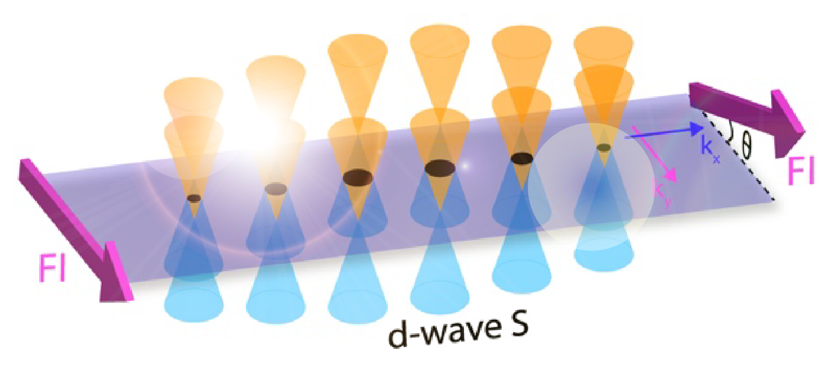In a ferromagnetic/nonmagnetic/ferromagnetic multilayer, the electrical resistance depends on the magnetisation alignment between the ferromagnetic layers: the resistance in the antiparallel (AP) state is higher than the parallel (P) state due to the differential scattering of majority and minority spin electrons. This is known as “giant magnetoresistance” (GMR) and was discovered in metallic multilayers in the 1980s (1, 2), laying a foundation for a multi-billion-dollar industry for spintronic memory and logic and led to the 2007 Nobel Prize in Physics.
Predating GMR, Pierre de Gennes (3) predicted a similar effect in which the nonmagnetic spacer between the ferromagnets is a superconductor. In this device the critical temperature (Tc) of the superconductor depends on the magnetisation alignment between the ferromagnetic layers with the potential to switch on and off the superconducting state leading to infinite GMR (4). Experimentally, however, values of ΔΤc = Tc (P) - Tc (AP) are typically a few tens of milli-Kelvin and negative meaning that the AP state favours superconductivity.
In our recent manuscript published in Nature Materials 18, 1194-1200 (2019), we report devices in which the unconventional superconductor YBa2Cu3O7-δ (YBCO) is sandwiched between layers of the ferromagnetic insulator Pr0.8Ca0.2MnO3 (PCMO) in which the origin of ΔΤc is fundamentally different to de Gennes (3): ΔΤc approaches 2 K with both the sign and magnitude of ΔΤc oscillating with YBCO thickness. The results provide evidence for an entirely new proximity effect in which the superconducting state controls the magnetisation alignment through nodal quasiparticle excitations on the Fermi surface of YBCO (see Figure). The results are central to the development of unconventional superconductivity and build a foundation for oxide superconducting memory/logic.
1. M. N. Baibich et al., Phys. Rev. Lett. 61, 2472-2475 (1988).
2. G. Binasch et al., Phys. Rev. B 39, 4828-4830 (R) (1989).
3. Bernardo et al., Nature Materials 18, 1194–1200(2019).
Figure caption: A schematic illustration of a device in which a d-wave superconductor is placed between two ferromagnetic insulators (FIs). The FIs induce an energy splitting of the low-energy quasiparticle excitations in the d-wave superconductor. The d-wave superconductor mediates magnetic information between the FIs and controls magnetization-alignment.

